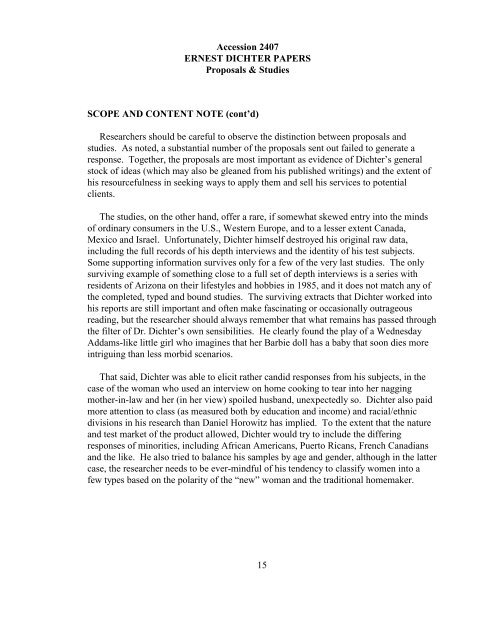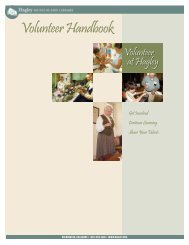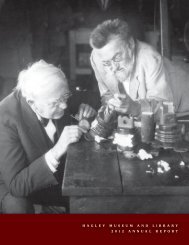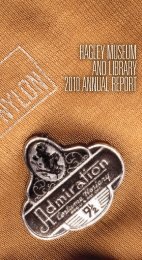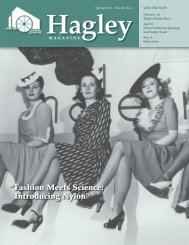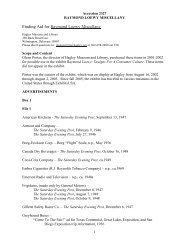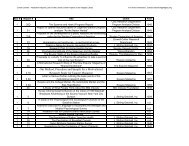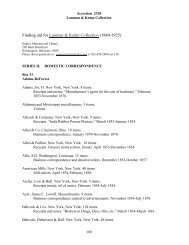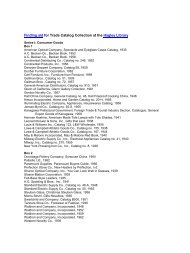Ernest Dichter Papers - Hagley Museum and Library
Ernest Dichter Papers - Hagley Museum and Library
Ernest Dichter Papers - Hagley Museum and Library
Create successful ePaper yourself
Turn your PDF publications into a flip-book with our unique Google optimized e-Paper software.
Accession 2407<br />
ERNEST DICHTER PAPERS<br />
Proposals & Studies<br />
SCOPE AND CONTENT NOTE (cont’d)<br />
Researchers should be careful to observe the distinction between proposals <strong>and</strong><br />
studies. As noted, a substantial number of the proposals sent out failed to generate a<br />
response. Together, the proposals are most important as evidence of <strong>Dichter</strong>’s general<br />
stock of ideas (which may also be gleaned from his published writings) <strong>and</strong> the extent of<br />
his resourcefulness in seeking ways to apply them <strong>and</strong> sell his services to potential<br />
clients.<br />
The studies, on the other h<strong>and</strong>, offer a rare, if somewhat skewed entry into the minds<br />
of ordinary consumers in the U.S., Western Europe, <strong>and</strong> to a lesser extent Canada,<br />
Mexico <strong>and</strong> Israel. Unfortunately, <strong>Dichter</strong> himself destroyed his original raw data,<br />
including the full records of his depth interviews <strong>and</strong> the identity of his test subjects.<br />
Some supporting information survives only for a few of the very last studies. The only<br />
surviving example of something close to a full set of depth interviews is a series with<br />
residents of Arizona on their lifestyles <strong>and</strong> hobbies in 1985, <strong>and</strong> it does not match any of<br />
the completed, typed <strong>and</strong> bound studies. The surviving extracts that <strong>Dichter</strong> worked into<br />
his reports are still important <strong>and</strong> often make fascinating or occasionally outrageous<br />
reading, but the researcher should always remember that what remains has passed through<br />
the filter of Dr. <strong>Dichter</strong>’s own sensibilities. He clearly found the play of a Wednesday<br />
Addams-like little girl who imagines that her Barbie doll has a baby that soon dies more<br />
intriguing than less morbid scenarios.<br />
That said, <strong>Dichter</strong> was able to elicit rather c<strong>and</strong>id responses from his subjects, in the<br />
case of the woman who used an interview on home cooking to tear into her nagging<br />
mother-in-law <strong>and</strong> her (in her view) spoiled husb<strong>and</strong>, unexpectedly so. <strong>Dichter</strong> also paid<br />
more attention to class (as measured both by education <strong>and</strong> income) <strong>and</strong> racial/ethnic<br />
divisions in his research than Daniel Horowitz has implied. To the extent that the nature<br />
<strong>and</strong> test market of the product allowed, <strong>Dichter</strong> would try to include the differing<br />
responses of minorities, including African Americans, Puerto Ricans, French Canadians<br />
<strong>and</strong> the like. He also tried to balance his samples by age <strong>and</strong> gender, although in the latter<br />
case, the researcher needs to be ever-mindful of his tendency to classify women into a<br />
few types based on the polarity of the “new” woman <strong>and</strong> the traditional homemaker.<br />
15


